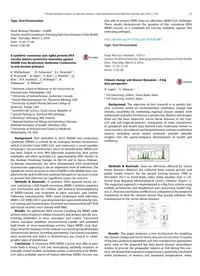
2016 A synthetic consensus anti-Spike protein DNA vaccine induces protective immunity against Middle East Respiratory Sy PDF
Preview 2016 A synthetic consensus anti-Spike protein DNA vaccine induces protective immunity against Middle East Respiratory Sy
17th International Congress on Infectious Diseases / International Journal of Infectious Diseases 45S (2016) 1–477 23 Type: Oral Presentation Final Abstract Number: 14.009 Session: Oral Presentations: Emerging Infectious Diseases & One Health Date: Thursday, March 3, 2016 Time: 15:45-17:45 Room: G.05-06 A synthetic consensus anti-Spike protein DNA vaccine induces protective immunity against Middle East Respiratory Syndrome Coronavirus in non-human primates K. Muthumani 1,∗, D. Falzarano 2, E.L. Reuschel 1, K. Kraynyak 3, K. Ugen 4, P. Kim 5, J. Maslow 5, J.J. Kim 3, N.Y. Sardesai 3, G. Kobinger 6, H. Feldmann 7, D. Weiner 8 1 Perelman School of Medicine at the University of Pennsylvania, Philadelphia, USA 2 University of Saskatchewan, Saskatoon, Canada 3 Inovio Pharmaceuticals Inc, Plymouth Meeting, USA 4 University of South Florida Morsani College of Medicine, Tampa, USA 5 GeneOne Life Science, Seoul, Korea, Republic of 6 Special Pathogens, National Microbiology Laboratory, Winnipeg, MB, Canada 7 National Institute of Allergy and Infectious Diseases, National Institutes of Health, Hamilton, USA 8 University of Pennsylvania School of Medicine, Philadelphia, PA, USA Background: First identified in 2012, Middle East respiratory syndrome (MERS) is caused by an emerging human coronavirus, which is distinct from SARS-CoV, and represents a novel member of lineage C betacoronoviruses. Since its identification, MERS-CoV has been linked to over 964 infections manifesting with severe morbidity and often mortality (i.e. approximately 400+ deaths) in the Arabian Peninsula, Europe, in the US and in Korea. Human- to-human transmission has been documented with nosocomial transmission appearing to be an important route of infection. The significant recent increase in cases of MERS in the Middle East, cou- pled with the lack of effective antiviral therapies or vaccines to treat or prevent this infection are significant causes for concern. Methods & Materials: A synthetic DNA plasmid based vac- cine containing a full-length consensus MERS-S protein sequence was constructed and the cellular and humoral immunogenicity of MERS-vaccine was evaluated in mice, macaues, and camels. Following immunization, NHPs were challenged with infectious MERS-CoV (EMC/2012) and monitored for signs of infection by clin- ical scoring and examinations. Viral load was measured by qRT-PCR and tissue sections were stained with H&E. Results: An optimized DNA vaccine encoding the MERS spike protein induced potent cellular immunity and antigen specific neu- tralizing antibodies in mice, macaques and camels. Vaccinated rhesus macaque monkeys seroconverted rapidly and exhibited high levels of virus-neutralizing activity. Upon MERS viral chal- lenge all of the monkeys in the control-vaccinated group developed characteristic disease, including pneumonia. Vaccinated macaques were protected and failed to demonstrate any clinical or radio- graphic signs of pneumonia. Conclusion: A consensus DNA MERS-vaccine was able to gen- erate both a strong T cell and neutralizing antibody response in multiple animal models, including camels, a natural host for MERS- CoV and a probable source of human infection. MERS-vaccine was also able to protect NHPs from an infectious MERS-CoV challenge. These results demonstrate the promise of this consensus DNA MERS-vaccine as a candidate for vaccine modality against this emerging pathogen. http://dx.doi.org/10.1016/j.ijid.2016.02.083 Type: Oral Presentation Final Abstract Number: 14.011 Session: Oral Presentations: Emerging Infectious Diseases & One Health Date: Thursday, March 3, 2016 Time: 15:45-17:45 Room: G.05-06 Climate change and disease dynamics - A big data perspective D. Lopez 1, G. Sekaran 2,∗ 1 VIT University, vellore, Tamil Nadu, India 2 VIT University, Vellore, India Background: The objective of this research is to predict dis- ease scenarios based on environmental conditions change and climatic variability by combining regional climate models with mathematical models for disease transmission. Malaria and dengue fever are the most important vector borne diseases in the trop- ical and sub-tropicalcountries. Integration of large repositories of geospatial and health data derived from traditional stream as vital statistics, surveillance and hospitalization, and non-traditional sources including social media networks provide valuable insights into the spatio-temporal determinants of health and wellbeing. Methods & Materials: Data on infectious affected by vector borne diseases (Malaria) are collected from various private and public health centres, for the period starting January 1998 to December 2013 in Tamil Nadu, India. Daily weather data is col- lected from Regional Meteorological Centre, Chennai (Figure 1). The suggested approach is implemented as a Big Data system using lambda architecture and MapReduce data processing model (Fig- ure 2). Pearson correlation coefficient is computed in the proposed framework to find the climatic factors that greatly influence the transmission of the vector borne diseases. Results: This paper proposes a new architecture for modeling the climate change and vector borne diseases in real-time. A variety of big data analytical algorithms and data visualization approaches were used in the proposed big data based disease surveillance system to present the geographic regions at risk during this cen- tury. We found that maximum temperature is positively correlated while incidences of malaria and minimum temperature, wind,
